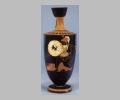
Overview
| Collection: | Museum of Art and Archaeology, Univ. of Missouri-Columbia |
| Summary: | Warrior running past fallen adversary. |
| Ware: | Attic Black Figure, Six's Technique |
| Painter: | Attributed to the Diosphos Painter |
| Date: | ca. 500 BC - 490 BC |
| Dimensions: | h. 19.6 cm; d. of rim 7.8 cm; d. of base 5.8 cm. |
| Primary Citation: | |
| Shape: | Lekythos |
| Beazley Number: | 2933 |
| Period: | Late Archaic |
Decoration Description:
Underneath of foot reserved, lower molding and upper surface of foot black-glazed, upper molding reserved with narrow red line on upper edge. Body of the vase black-glazed, shoulder with lotusbuds, with the stalks skipping one, and tongues. Mouth and lip black, with added red on lip; interior of mouth black, handle black on exterior, reserved inside; one red band at the junction with foot, one below picture, and two above.
Figures: warrior carrying shield in one hand, sword in the other, rushes (l.) past a fallen, naked adversary. Warrior wears chiton, corslet and helmet. Arms, legs, chiton, sword and face rendered in incision on the black field, with double incised lines around shield. Added color: purple-red on inner curve of crest, locks of hair protruding from lower part of helmet (on side and behind); bandoleer, scabbard opening and knob at lower end with vertical stripes at regular intervals between; edges of hanging folds in lower part of corslet; blood on sword and dripping from it; dull brick red for helmet and scabbard; light buff for crest of helmet, corslet, sword handle and shield; darker buff on middle part of corslet, vertical stripes over hanging folds of corslet, rim of shield. Shield device in black (verging on brown) perhaps a dog. Fallen warrior lies with left leg crossed over right. Added color: Flesh color for body with anatomical details incised; purple red for hair fillet and blood dripping from wounds in breast and right thigh. Letters are painted in red above the shield, between the shield and fallen body, and behind the helmet of the warrior. The inscriptions are without meaning.
In terms of iconography and composition, one is reminded strongly of the battling figures from the pediments of the temple of Aphaia at Aegina, which are contemporary with this vase. The last quarter of the sixth century was characterized by conceptual advancements in the treatment of the human figure, spatially and naturalistically. It was a period of experimentation with artistic techniques which could facilitate these objectives; namely, the use of bronze in rendering three-dimensional figures on a large scale, and the introduction of the red-figure technique in vase-painting. This vase was decorated by the Diosphos Painter, a black-figurist, and it is painted in an unusual technique related to black-figure, called Six's technique after the Dutch scholar, Jan Six, who first studied it. The range of added color is broad and the color is applied with a brush to the surface of the vase, which has been coated with black-glaze matter. Like black-figure, many details are incised (
The light-colored areas on this lekythos, like red-figure itself, utilize the natural spatial advantage and added animation that any lighter elements have against a dark background. Even within an uncommon type, this vase is unusual; the fallen male is depicted in lighter color, recalling red-figure, while the striding male is in "Six" black. Significantly, the fully developed Six's technique as shown on this vase may give some reflection of the richness of wall painting of the period, with regard to color. If spatial concerns were important to the artist — he does try to foreshorten the body of the fallen warrior — his success is ambiguous. The sculptors of the earlier Aegina pediment had a similar interest in space and equal difficulty in achieving it. Although the lighter painted portions of the figures on the Missouri lekythos stand away from the black field and take on added life, the figure of the striding warrior, insofar as he shares the same black as the field and is too indistinctly separated from it, appears anchored and flat. Like a specter in negative, his foot, in black, seems to cut the lighter body of the fallen warrior in half, obviously, as Kurtz implies (
"The Diosphos Painter's use of Six's technique is similar to his use of semi-outline; just as he liked to balance light (outline) and dark (silhouette) on white ground, he likes to balance dark (incised) and light (added color) on black" (
The Missouri lekythos is remarkable for its extremely fine state of preservation and for its style which provides valuable opportunity to view something of an eleventh-hour attempt on the part of a still gifted black-figurist to revitalize his craft in the face of the ever-increasing popularity of red-figure painting.
Shape Description:
Tall, narrow body with sloping shoulder sharply marked off from body; mouth straight, high and flat-topped; handle slightly concave; foot in two degrees, lower one in a torus molding (shape DL).
Material Description:
Red clay, well-levigated.
Essay:
Collection History:
Museum Purchase
Sources Used:
Other Bibliography:
Muse 3 (1969) 24-28